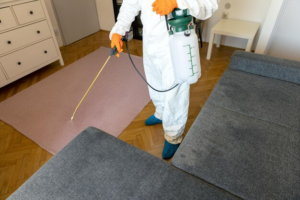
There are three species of Carpet Beetles in California, Varied, Furniture and Black. The names are somewhat deceptive, as both Varied and Furniture Carpet Beetles will both be found on and eating select furniture. Black Carpet Beetles can be both brown and black. Their names are also archaic because carpets are no longer made of animal byproducts (in this case, wool), so a more appropriate name for them would be skin-fur beetle or shed beetle, but we’ll get into their appetite later. We’ll focus most on Varied Carpet Beetles, which are the most common.
Carpet beetles may be small, but their potential for damage is significant. Often confused with clothes moths, these tiny pests feed on natural fibers and can quickly ruin rugs, furniture, and clothing. Understanding their lifecycle, habits, and what attracts them is essential for effective prevention and control.
Pasadena Pest Control is here to help you identify and eliminate these destructive insects from your home as well as answer any questions you may have about Carpet Beetles.
Life Cycle of Carpet Beetles
Carpet beetles go through four stages in their life cycle: egg, larva, pupa, and adult. Knowing this cycle helps in early detection and effective treatment.
- Eggs: Female carpet beetles typically lay around 40 eggs, usually on food sources made from animal byproducts such as animal skins, carpets, clothing, upholstery, particularly woolen items. They may also be found in leather-bound books. Eggs hatch in one to two weeks. Outside, they can be found in spider webs and nests of wasps, birds, and rodents.
- Larvae: The larvae are the most damaging stage, lasting from several months to two years. Larvae appear as small, hairy caterpillars and actively feed on organic materials.
- Pupa: The larvae spin cocoons and enter the pupal stage, typically lasting one to two weeks, transforming into adults.
- Adults: Adult carpet beetles primarily feed on nectar and pollen, living about two to eight weeks. Adults typically enter homes through open windows and doors or gaps, attracted by light.
Where Do Carpet Beetles Live? (Habitat)
Carpet beetles are common indoor pests, found most often in areas where food sources and hiding places are abundant:
- Carpets, rugs, and upholstery
- Closets and storage areas with clothing or textiles
- Attics, basements, and unused rooms
- Areas behind furniture or appliances
- Window sills and light fixtures (adult beetles are attracted to light)
Outdoor adult beetles are typically found on plants, flowers, and bird nests, from which they often migrate indoors.
What Do Carpet Beetles Eat?
Carpet beetle larvae have a strong appetite for natural fibers and animal-based materials. Common sources of food for carpet beetles include:
- Wool rugs and carpets
- Silk, wool, leather, and fur clothing
- Feathers, pillows, and bedding
- Animal hair and pet fur
- Stored pantry products (dry pet food, grains, cereals)
Adult carpet beetles feed primarily on pollen and nectar outdoors but will lay eggs near suitable food sources indoors.
How Do Carpet Beetles Enter Your Home? (Sources)
Understanding where carpet beetles come from can help you stop infestations before they start:
- Open doors, windows, and vents
- Contaminated furniture, rugs, or clothing brought into the hombede
- Bird or rodent nests near or inside the house
- Flowers or plants from the garden
Tips for Carpet Beetle Control and Prevention
To effectively control carpet beetles, combine professional pest control with these preventive measures:
1. Regular Cleaning and Vacuuming
Frequently vacuum carpets, rugs, and upholstery to remove eggs and larvae. Pay special attention to hidden areas like closets and under furniture and the seams of the furniture and of the carpet, where it meets the baseboard.
2. Inspect Second-Hand Items
Before bringing used furniture, rugs, or clothing into your home, thoroughly inspect and clean them to ensure they’re beetle-free.
3. Seal Entry Points
Make sure windows and doors have intact screens. Seal cracks around doors, windows, vents, and utility pipes.
4. Proper Storage
Store clothing and textiles in sealed containers or bags. Regularly clean closets and storage spaces to disrupt potential breeding sites.
5. Professional Treatments
Professional pest control treatments are essential for severe infestations. Experts can accurately identify the source and apply specialized treatments that effectively eliminate all stages of carpet beetles. The treatment can vary from a simple interior baseboard treatment to a treatment covering the baseboards, carpets, furniture and exterior depending on the severity and the source.
Call Pasadena Pest Control Today for an Expert Assessment
Don’t let carpet beetles damage your valuable belongings and home interiors. And don’t let pass potential nest presence within your home. Pasadena Pest Control offers thorough inspections to identify the sources of infestations, followed by a customized treatment plan to eliminate these pests once and for all.
Call Pasadena Pest Control today for an expert assessment of your property, and let our skilled technicians protect your home from unwanted invaders like carpet beetles!
